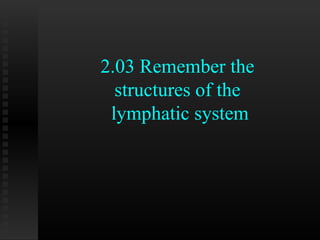
Structures of the Lymphatic System
- 1. 2.03 Remember the structures of the lymphatic system
- 2. 2.03 Remember the structures of the lymphatic system What are the structures of the lymphatic system? 2.03 Remember the stuctures of the 2 lymphatic system
- 3. Structures of the lymphatic system id Lymph flu id L Lymph vessel s nodes L ymph L ymph g lands 2.03 Remember the stuctures of the 3 lymphatic system
- 4. Structures of the lymphatic system Lymph fluid water lymphocytes some granulocytes oxygen carbon dioxide digested nutrients hormones salts urea 2.03 Remember the stuctures of the 4 lymphatic system
- 5. Structures of the lymphatic system Lymph vessels 2.03 Remember the stuctures of the 5 lymphatic system
- 6. Structures of the lymphatic system Lymph vessels parallel to blood vessels 2.03 Remember the stuctures of the 6 lymphatic system
- 7. Structures of the lymphatic system Lymph vessels •Lacteals •Lymphatics 2.03 Remember the stuctures of the 7 lymphatic system
- 8. Structures of the lymphatic system Two large main Lymphatics *Thoracic Duct (Left Lymphatic Duct) * Right Lymphatic Duct 2.03 Remember the stuctures of the 8 lymphatic system
- 9. Structures of the lymphatic system Lymph nodes Lymph node 2.03 Remember the stuctures of the 9 lymphatic system
- 10. Structures of the lymphatic system Lymph nodes •Where are lymph nodes located? •Why are there so many? 2.03 Remember the stuctures of the 10 lymphatic system
- 11. Structures of the lymphatic system Tonsils 2.03 Remember the stuctures of the 11 lymphatic system
- 12. Structures of the lymphatic system Say “aahhh” Why this is helpful? 2.03 Remember the stuctures of the 12 lymphatic system
- 13. Structures of the lymphatic system Spleen 2.03 Remember the stuctures of the 13 lymphatic system
- 14. Structures of the lymphatic system Thymus gland 2.03 Remember the stuctures of the 14 lymphatic system
- 15. 2.03 Remember the structures of the lymphatic system What are the structures of the lymphatic system? 2.03 Remember the stuctures of the 15 lymphatic system
Notas del editor
- straw-colored fluid similar to plasma. Lymph fluid is also called interstitial fluid because it surrounds the spaces between tissue cells. It is composed of water, lymphocytes, some granulocytes, oxygen, digested nutrients, hormones, salts, carbon dioxide and urea. It acts like an go-between for blood in the capillaries and the tissues. It carries digested food, oxygen, and hormones to the cells. Carries metabolic waste products like CO2 and urea waste away from the cells and back into the capillaries for excretion.
- Run parallel to blood vessels (veins) and transports lymph. Lymph vessels are located in almost all organs and tissues that have blood vessels. They are NOT in the cuticle, nails, and hair.
- Specialized lymph vessels in the small intestines that absorb digested fats and transport them to the circulatory system. The lymph fluid enters small lymph vessels which join and form a bigger vessel called lymphatics.
- There are two large main lymphatics Thoracic duct (left lymphatic duct) - receives lymph from the left side of the chest, head, neck, abdominal area, and lower limbs. Lymph in the thoracic duct is carried to the left subclavian vein and from there to the superior vena cava and the right atrium. Right lymphatic duct -receives lymph from the right arm, right side of the head, and upper trunk enters the right lymphatic duct. From there it enters the right subclavian vein at the right shoulder then flows into the superior vena cava. Lymph only flows in one direction- from the body to the heart.
- tiny, oval-shaped structures range in size from a pinhead to an almond
- Located alone or grouped in various places along the lymph vessels throughout the body. The immune response is activated when lymph reaches the node. Lymphocytes are released into the lymph fluid.
- 3 pairs- most common is palatine which are located on the sides of the soft palate. The tonsils on the upper part of the throat are called adenoids. The third pair are located at the back of the tongue are called lingual. Tonsils are masses of lymphatic tissue which are capable of producing lymphocytes and filtering bacteria. In extreme cases, the tonsils will be surgically removed.
- Moves the uvula up and the tongue down so the doctor can visualize the tonsils
- Sac-like mass of lymphatic tissue which is located in the LUQ just below the diaphragm. The spleen forms lymphocytes and monocytes. Blood passing through the spleen is filtered. The spleen will also store large amounts of RBCs. When there is excessive bleeding or vigorous exercise, the spleen can contract which will cause the stored RBCs into circulation. The spleen also destroys and removes old or fragile RBCs. In embryos, the spleen forms erythrocytes.
- Thymus gland is located in the upper, anterior chest above the heart It is mostly made up of lymphatic tissue that is why it is classified as a lymphatic organ. However it is also considered an endocrine gland because it secretes a hormone called thymosin (stimulates the production of lymphoid cells) Its function is to produce lymphocytes What is unique about the thymus gland?
- Lymph fluid Lymph vessels Lymph nodes Lymph organs tonsils thymus spleen